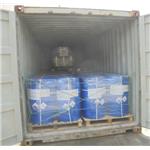Description
Cysteamine is a stable aminothiol with radioprotective activities. It reduces ionizing radiation-induced death and chromosomal damage in mice in a dose-dependent manner. Cysteamine binds rapidly and temporarily to plasma proteins upon administration and this activity is directly correlated to its radioprotective effects.
In vitro, 0.1 mM cysteamine depletes 90% of free cystine from cystinotic fibroblasts. Formulations containing cysteamine have been used to treat nephropathic cystinosis and reduce glomerular deterioration in humans.
Chemical Properties
White Solid
Uses
Cysteamine hydrochloride has been used in the
in-situ generation of chiral cysteamine-capped cadmium sulfide quantum dots (CA-CdS QDs) for the sensing of Cd
2+ and S
2-.
Uses
An inhibitor of DMBA-induced mammary tumors2-Mercaptoethylamine hydrochloride acts as a precursor in taurine biosynthesis and component of coenzyme A. It is involved in the preparation of active pharmaceutical ingredients like ranitidine and nizatidine. It acts as an antidote for acetaminophen poisoning. Further, it is used in the oral treatment of nephropathic cystinosis, radiation sickness and disorders of cysteine excretion. In addition to this, it serves as an antioxidant and an inhibitor of 7,12-Dimethylbenz[a]anthracene (DMBA)-induced tumors.
Uses
Cysteamine hydrochloride is used as an antioxidant and in radiation therapy.
General Description
Cysteamine is an aminothiol that can reduce important oxidized disulfide molecules such as cystine to yield cysteine.
Hazard
Toxic by inhalation and ingestion.
Biochem/physiol Actions
Cysteamine is an aminothiol that can reduce important oxidized disulfide molecules such as cystine to yield cysteine. Cysteamine is used in a wide range of applications from regulation of gene expression, to depletion of somatostatin, to coating of nanoparticles.
Synthesis
In particular to synthesizing cysteamine hydrochloride in alkali surroundings, which is characterized in that ethanolamine solution and sulfate solution are used as raw material; 2- amino ethyl sulfate is firstly synthesized before made into ring in alkaline solution by 2-amino ethyl sulfate and carbon disulfide, thereby getting Alpha -mercaptothiazoline; alkaline hydrolysis is made upon Alpha -mercaptothiazoline to produce cysteamine hydrochloride.
Purification Methods
Purify the salt by recrystallisation from EtOH. It is freely soluble in H2O and should be stored in a dry atmosphere. [Mills & Bogert J Am Chem Soc 62 1177 1940.] The picrate has m 125-126o; see previous entry for free base. [Beilstein 4 IV 1570.]





